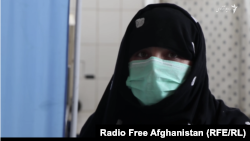SEEBAK BAZAR, Afghanistan – A village some 70 kilometers south of the Afghan capital, Kabul, is typical of the predominantly rural areas controlled by the Taliban.
In Seebak Bazar, part of the Taliban-controlled Chak district in the central Maidan Wardak Province, life has adopted a somewhat normal pace. The ramshackle shops in the mud buildings along its dusty main street continues to attract customers as bearded Taliban fighters can be often seen patrolling the village.
But in sharp contrast to teeming Afghan cities, Kabul in particular, few women are seen in Seebak Bazar. Those venturing out of their homes, mostly with male guardians, must wear chadri or veils.
While girls can go to school, women have few employment opportunities. Twenty-nine-year-old Khalida, a midwife, is among the six women employed at a local health clinic. She works in strict segregation from her male colleagues.
“I am happy to serve the residents of my native village,” she told Radio Free Afghanistan as she covered her face with a surgical mask. “I have been working here for the past year.”
Khalida, who goes by one name only, however, was allowed to speak in a brief interview supervised by her Taliban minders. The mother of five had previously worked for two years in Jaghatu, another district in Maidan Wardak.
Khalida and her female colleagues were not invited to participate in an event held by local Taliban leaders and male medical staff to spread awareness about the coronavirus pandemic. All participants of the event were men from Seebak Bazar and nearby villages.
Her circumstances provide a brief insight into what the Taliban’s signals about changes to their outlook on women’s rights mean in reality. Leaders of the hard-line Islamist movement have frequently highlighted their intention to honor women’s rights so long as they are in line with their interpretation of Islam.
“We together will find a way to build an Islamic system in which all Afghans have equal rights, where the rights of women that are granted by Islam — from the right to education to the right to work — are protected,” Sirajuddin Haqqani, the Taliban’s deputy leader, wrote in an op-ed in the New York Times on February 20.
But based on the current status of women in Taliban-controlled regions, it might mean that women will have token access to employment in essential jobs such as health workers or teachers. They will, however, be denied leadership roles and will have to work in strict gender segregation.
This is in stark contrast to the status of women in areas controlled by the Afghan government. In Kabul, women have access to education and employment, and enjoy a range of free movement and are a part of all walks of life. Women athletes are considered national heroes while female artists are celebrities. Women also have senior leadership positions in most branches of the government whose leaders insist on being committed to gender equality and protecting women’s rights.
Lawmaker Nilofer Ibrahimi, a physician in her 40s, remembers being repeatedly beaten by the Taliban for serving as a healthcare worker during their stint in power in the late 1990s.
“The Taliban must remember that the status of women in Afghanistan is not the same as it was 20 years ago,” she told Radio Free Afghanistan. “I did not give up working despite repeated beatings two decades ago, and now that I represent people, will it be easy to silence me?”
As the Afghan government anticipates engaging in peace talks with the Taliban, the status of women is likely to be a major point of contention. The Afghan government has already nominated scores of prominent women to represent it and all other factions supporting the current political system in complex future negotiations with the Taliban.
The Taliban, however, have no known women negotiators. No woman has ever held a leadership position in the movement.
Abubakar Siddique wrote this based on reporting by Nusrat Parsa and Nasim Shafaq from Seebak Bazar and Kabul, Afghanistan.







